Protecting Home-Cured Meat from Insects and Mites
ENTFACT-638: Protecting Home-Cured Meat from Insects & Mites | Download PDF
by L.H. Townsend, Extension Entomologist
University of Kentucky College of Agriculture
Mites, beetles, and maggots are pests that can attack meats during curing and storage. Only a small number are necessary to begin a damaging infestation. No insecticides can be applied directly to infested meats so proper measures must be taken to prevent infestation. Start with a clean, pest-free storage area. Wrapping hams in paper or putting them into cloth bags offers some protection. Finally, inspect the meat regularly, at least once a month, to detect any problems that may be developing.
Site Preparation
Sanitation, a "clean-out" treatment, and sealing of the storage area, are the keys to preventing problems. Sanitation is the foundation of a good storage program. The pests involved can survive on small pieces of meat, trimmings, or grease, as well as a variety of other animal products. Thoroughly sweep out the area and vacuum it. Use a crevice tool on cracks and crevices in shelves, walls and floors. Scrub all surfaces with hot soapy water to remove any accumulations of grease. Seal all cracks and crevices to keep them from being hiding places for pests.
Insecticide applications should be limited to pyrethrins. Treatment should be made only when the storage area is empty. Pyrethrins kill on contact but leave no residue. This is why thorough sanitation is needed to clean out hiding spots before treating the area. No insecticides can be applied directly to the meat and none can be applied while meat is in the room. Carefully read the product label and follow all directions.
Last, keep pests from entering the room after it has been prepared. Small crawling or flying insects are most likely to enter by doors or windows. Make sure that doors and windows close tightly and are closed with 30 mesh or finer screens. Check for and plug any other entry ways that are found.
Storage Conditions
Cover smoked meats completely by placing them in sacks or wrappers. This will prevent some pest infestations.
Keep the curing area cool (55°F to 60°F if practical) and dry to slow the development of pests. Some pests, such as mites, require relatively high humidity to thrive.
Inspect the surface of the products carefully and at regular intervals during the warmest periods. Use a magnifying glass and flashlight so that you can easily detect these small pests. Examine the area below the hams for signs of activity - shed skins or waste droppings. Check the store room for entry sites and close and seal them.
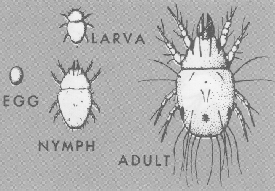
Ham Mite Life Cycle
Pests
Mites are very tiny (1/32 inch long) and feed on the surface of cured meat. They also may infest grain, cheese, and flour. Magnification is necessary to confirm the presence of this pest. Mites do not fly but can crawl and easily may be carried from place to place on infested materials. Feed, seeds, or seed-based rodent baits can be sources.
Heavily infested materials may have a sweet or "minty" odor and the surface may appear to move if mites are extremely numerous. Over time, infested areas have a powdery appearance from the buildup of dead mites and their shed outer coverings. Since infestations are limited to the surface, it may be possible to brush most of the mites off. A light coat of vegetable oil can be rubbed thoroughly over the surface to kill the remaining mites and eggs. Repeat the treatment in 7 to 10 days. Improve ventilation as much as possible.
A female can produce up to 800 eggs which are scattered singly over the surface of the meat. The life cycle can be completed in 2-1/2 weeks during the summer and requires about 4 weeks in the winter.
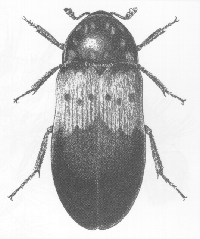
Adult Larder Beetle
Larder beetles are 1/4 inch to 3/8 inch long dark brown beetles. A wide yellow band with six dark spots can be seen on the first one-third of the wing covers. The larval stage is covered with hair-like bristles. There are two sharped curved spines on the end of the elongate body. Full grown larvae leave the food source to find a place to change to the adult stage. These wandering larvae, which can burrow into wood, may be the first sign that an infestation is present.
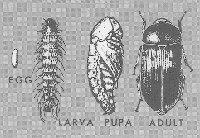
Larder Beetle Life Cycle
Larder beetles infest a variety of meats, animal products such as feather and fur, dried foods, or even accumulations of dead insects in wall voids. Each female lays about 100 eggs which hatch in about two weeks. The larvae feed on or just below the surface of the meat. Damaged areas may be trimmed away and discarded. Brush the surface thoroughly to remove eggs and small larvae. A vegetable oil application to the surface of the meat may help to control early stages of the insect.
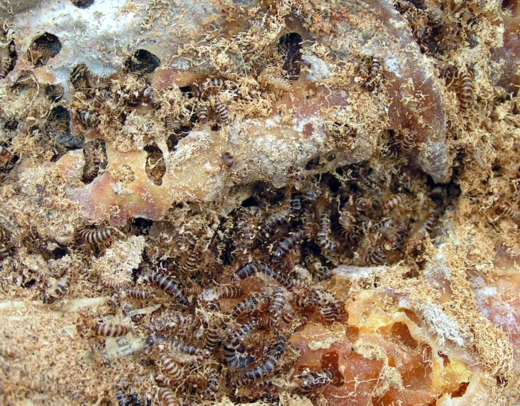
Larder beetle larvae feeding on a country ham (P. Konopka, 2005)
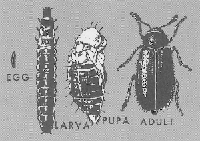
Red-Legged Ham Beetle Life Cycle
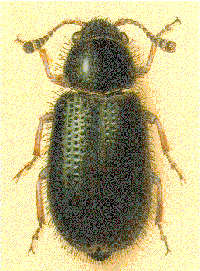
Red-Legged Ham Beetle
Red-legged ham beetles attack cured and dried smoked meats. The long, slender, purplish larvae are about 1/4 inch long. They burrow into the meat, seeming to prefer fat. The greenish-blue adults, about 1/4 inch long, have red legs. Adults feed on the meat but are not as destructive as the larvae. Their life cycle takes from 1 to 3 months, depending upon the temperature.
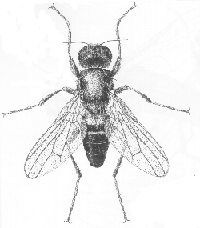
Adult Skipper
Skippers, which get their name from their distinctive means of moving, are the larval stages of small flies. Adults, about one-third the size of a house fly, are black with a bronze tint and red-brown eyes. Skippers are scavengers and can develop on a wide range of organic wastes. Substances with a putrid odor are preferred by the adults as sites on which to lay eggs.
The slender, bullet-shaped maggot is the damaging stage. They usually occur in groups and prefer dark areas. They can arch their body and flip themselves several inches in a powerful "skip". The life cycle from egg to adult can be completed in as few as 12 days during warm weather. Several thousand individuals can be produced in a single ham.
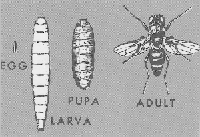
Cheese Skipper Life Cycle
Infestations begin when the female fly lays her eggs on the meat surface, usually near the butt end of newly smoked hams and shoulders. The maggots develop in soft muscles and connective tissue. This pest burrows deeply into the meat rather than remaining near the surface like most of the other pests do. Mature larvae usually leave the meat and crawl to a tight, dry crevice to pupate and transform to the adult stage. There is no effective treatment for this insect. Heavily infested hams should be discarded and the area cleaned thoroughly to collect pupa that may be present in nearby cracks and crevices.
Infested Meats
Brush off surface infestations of mites thoroughly and trim off surface damage by insects such as larder beetles or red-legged ham beetles. Cut deeply enough to remove larvae that may have moved along the bone or through layers of fat. Disinfested meat is safe to eat but should be used promptly.
Revised: 5/07
CAUTION! Pesticide recommendations in this publication are registered for use in Kentucky, USA ONLY! The use of some products may not be legal in your state or country. Please check with your local county agent or regulatory official before using any pesticide mentioned in this publication.
Of course, ALWAYS READ AND FOLLOW LABEL DIRECTIONS FOR SAFE USE OF ANY PESTICIDE!
Images: USDA Cooperative Extension unless otherwise noted
